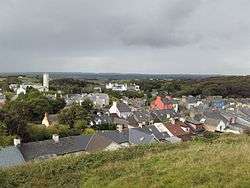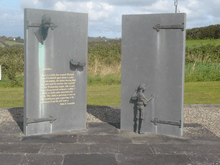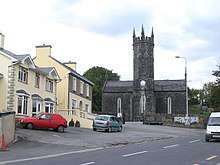Ennistymon
| Ennistymon Inis Díomáin | |
|---|---|
| Town | |
 | |
 Ennistymon Location in Ireland | |
| Coordinates: 52°56′N 9°17′W / 52.94°N 9.29°WCoordinates: 52°56′N 9°17′W / 52.94°N 9.29°W | |
| Country | Ireland |
| Province | Munster |
| County | County Clare |
| Population (2016) | |
| • Urban | 1,045 |
| Time zone | UTC+0 (WET) |
| • Summer (DST) | UTC-1 (IST (WEST)) |
| Irish Grid Reference | R134877 |
Ennistymon or Ennistimon (Irish: Inis Díomáin) is a country market town in County Clare, near the west coast of Ireland. A popular tourist spot, it has a typical Irish main street, with many traditional pubs. The River Inagh, with its small rapids known as the Cascades, runs through the town, behind the main street. A bridge across the river leads to nearby Lahinch, on the N67 national secondary road. The town is connected to Ennis by the N85, continuing the settlement's main street.
Name
The town's official name is Ennistimon, although Ennistymon is the spelling most widely used.[1] Historically, it was spelled Inishdymon.[1] This is believed to derive from Inis Diomáin meaning "Diomán's island".[1] However, Míchéal Ó Raghallaigh argues that the name is derived from Inis Tí Méan meaning "island of the middle house" or "river meadow of the middle house".[2]
Geography
Ennistymon is located on the border of the upland area of County Clare known as the Burren. The Cullenagh River is called Inagh after the Ennistymon cascades, at which point it becomes tidal.[3]:53-5
History
Ennistymon grew from just three cabins in 1775 to 120 houses in 1810 (70 of which were slated). The oldest part of town is the narrow street near the bridge. A Christian Brothers Monastery, Mount St. Joseph's, was established in 1824.[3]:54,56
Economy
There are many shops in Ennistymon including a large SuperValu supermarket, an Aldi supermarket, bakery, several hairdressers, a butcher, a hardware shop, print shop, dry cleaners, launderette, builders' suppliers, several cafés and restaurants and one hotel along with numerous B&Bs. There are also numerous pubs, many of which host Irish traditional musicians.
Infrastructure
Transport
Bus
Two Bus Éireann routes, 333 and 350, serve the town. Route 350 links Ennistymon to Ennis, Lahinch, Cliffs of Moher, Doolin (where it is possible to connect with a ferry to the Aran Islands), Lisdoonvarna and Galway. There are a number of journeys each way daily. Onward rail and bus connections are available at Ennis and Galway. Route 333 links the town to Kilfenora, Corofin, Miltown Malbay and Doonbeg.
Rail
The West Clare Railway formerly passed through the town, connecting it to Ennis and the West Clare coastal towns and villages. Ennistymon railway station opened on 2 July 1887. The railway closed on 1 February 1961.[4]
Notable places

- Teach Ceoil Saint Andrews, Gothic Revival Church of Ireland from the 1830s, converted to a hall in 1989[5]
- The Falls or Cascades (waterfall)
- The Falls Hotel (formerly Ennistymon House, a Georgian house built on the site of an earlier castle)
- A number of the town houses are deemed architecturally interesting/valuable and are listed in the National Inventory of Architectural Heritage[6]
- Ruined church and graveyard. Located on a hill, the nave-and-chancel church was built in 1778 and fell into disuse after the new Church of Ireland was constructed in the 1830s. It features a single Gothic door, three windows on the north and one the east side. The building measures 7 by 14 meters. This was a Protestant church, built by the Archdeacon of Kilfenora, James Kenny (appointed in 1775).[3]:54-5
- Ruins of Glen Castle, near the road to Ennis
Memorial

The An Gorta Mór ("The Great Hunger") Memorial was erected a mile outside Ennistymon on the road to Lahinch to commemorate the memory of the victims of the Great Famine from 1845 to 1850. It was dedicated on 20 August 1995 – the 150th anniversary of the Famine. Located across from Palladian Ennistymon Hospital, itself built on the grounds of the local workhouse (Union of Kilmanaheen), it was erected by a combined effort of the Ancient Order of Hibernians (AOH), Board of Erin, Board of America and Clare County Council.
The monument was designed by an artist from Co Kerry and depicts an account found in the Minutes of the Meetings of the Boards of Guardians for Ennistymon Union held in the County Archives.[7] The account centered on a note that was pinned to the torn shirt of a barefoot orphan boy who was left at the workhouse door on the freezing cold morning of 25 February 1848. The note read:
Gentlemen,
There is a little boy named Michael Rice of Lahinch aged about 4 years. He is an orphan, his father having died last year and his mother has expired on last Wednesday night, who is now about to be buried without a coffin!! Unless ye make some provision for such. The child in question is now at the Workhouse Gate expecting to be admitted, if not it will starve. -- Rob S. Constable''
One side of the memorial depicts a child standing before the workhouse door, while across from that is the head of an anguished mother and two hands clenched in frustration or anger above the sorrowful text of the pleading note.
Education
Ennistymon has two primary schools: Scoil Mhainchin/Ennistymon National School and Mol an Oige Steiner School.[8] Mol an Oige Steiner National School recently became the first Steiner method school in Ireland to be given permanent recognition as a national school by the Department of Education.[9]
Scoil Mhainchin is in an amalgamation of the CBS Primary School and The Convent of Mercy National School. There are also three secondary schools in the town: Ennistymon CBS, which is the only all-boys school in the county, the Vocational School and Scoil Mhuire provide secondary education.[10][11][12] Plans are in place to amalgamate these three schools.[13]
Parish of Ennistymon

The Parish of Ennistymon has three churches; Ennistymon, Lahinch and Clouna. The church in Furglan was closed reducing the number of churches from four to three. The Church of Ireland church at Ennistymon was built in 1831. The current Roman Catholic church in Ennistymon, Church of the Blessed Virgin Mary and Saint Michael, was built in 1952-1954.[14][15]
Notable people
Born
- William O'Brien, 2nd Marquess of Thomond, Irish peer
- Kootenay Brown (by birth John George Brown), Irish-Canadian polymath, soldier, trader and conservation advocate
- Martin Conway, Irish Fine Gael politician
- Seamus Mac Cruitín, Irish poet and bard
- Marie Davenport, Irish former female long-distance runner
- Brian Merriman, Irish language poet and teacher (a statue of him stands outside St Andrew's church)
- William Rynne, Irish Republican who fought in the 1916 Rising
Town twinning


See also
References
- 1 2 3 "Inis Díomáin/Ennistimon". Logainm.ie. Retrieved 30 October 2017.
- ↑ Míchéal Ó Raghallaigh:Scríobhaí ó Inis Díomáin, "The Other Clare", vol. 16 (Shannon, 1992), p. 18.
- 1 2 3 Cunningham, George (1980). Burren Journey West. Shannonside Mid Western Regional Tourism Organisation. ISBN 0-9503080-2-1.
- ↑ "Ennistymon station" (PDF). Railscot - Irish Railways. Retrieved 2007-10-13.
- ↑ "National Inventory of Architectural Heritage - Teach Ceoil Saint Andrews, Church Street, Ennistymon, County Clare". Department of Arts, Heritage & the Gaeltacht. Retrieved 23 December 2016.
- ↑ "National Inventory of Architectural Heritage - Ennistymon, County Clare". Department of Arts, Heritage & the Gaeltacht. Retrieved 23 December 2016.
- ↑ "Ennistymon Union Minute Books 1839 - 1850". Clarelibrary.ie. Retrieved 30 October 2017.
- ↑ Henderson, Rob. "Mol an Óige Steiner National School - Mol an Óige - Steiner National School". Steinermolanoigens.org. Retrieved 30 October 2017.
- ↑ Ryan, Nicky. "Ireland now has its first (official) Steiner National School". Thejopurnal.ie. Retrieved 30 October 2017.
- ↑ Henderson, Rob. "Meánscoil na mBráithre Inis Díomáin". Cbsennistymon.com. Retrieved 30 October 2017.
- ↑ "Ennistymon Vocational School Home Page". Ennistymonvocationalschool.com. Retrieved 30 October 2017.
- ↑ "Scoil Mhuire Ennistymon". Scoil Mhuire Ennistymon. Retrieved 30 October 2017.
- ↑ Team, Fujitsu/Oireachtas Lotus Notes/Domino Development. "Parliamentary Debates". Oireachtasdebates.oireachtas.ie. Retrieved 30 October 2017.
- ↑ "Clare Places - Ennistymon: Places of Interest". Clarelibrary.ie. Retrieved 30 October 2017.
- ↑ "National Inventory of Architectural Heritage - Church of the Blessed Virgin Mary and Saint Michael, Ennistymon, County Clare". Department of Arts, Heritage & the Gaeltacht. Retrieved 23 December 2016.
External links
| Wikimedia Commons has media related to Ennistymon. |
